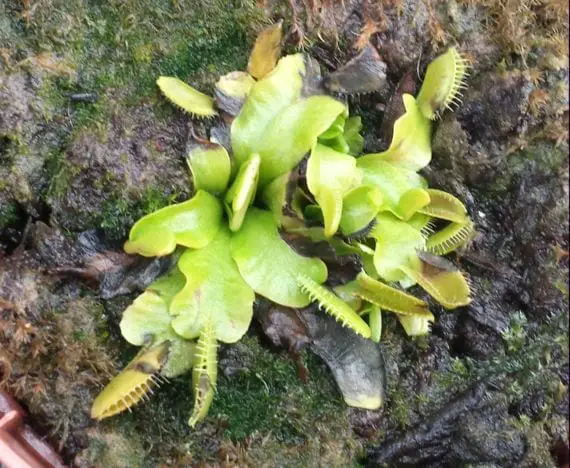With the arrival of the cold our carnivorous they begin to slow down more and more the growth rate, to take out smaller and smaller leaves, and / or to lose said leaves. They have entered a state of hibernation.
The duration of this state depends on the climate we have. It will be longer if it is colder, or shorter if it is warmer. Generally, it should last a few three months.
Most carnivorous plants are of tropical or subtropical origin. Some, like the Venus flytrap (top photo) or the Sarracenia (bottom photo) can withstand very weak and very short-lived frosts.
If we live in a climate with frosts down to -3º, we can have our plants outside, allowing them to hibernate naturally. Otherwise, we must protect them in greenhouses, terrariums or indoors until the risk of frost has passed.
Outdoor plants: natural hibernation
From spring to late autumn, the growth rate is normal. They take leaves, they hunt, they even bloom. But, with the arrival of the cold, we see that they grow more slowly, some traps begin to dry up, smaller and smaller leaves sprout, … It will be time to start spreading the risks. If we have a plate or tray under them, I advise removing it on the days when there is a forecast of rain, since the roots could rot and we could lose the plant.
It is highly recommended to remove the dry leaves to avoid the proliferation of fungi.
Indoor plants: artificial hibernation
If we live in a hot or very cold climate, we will have no choice but to create a winter for our carnivores in the first case or by protecting them at home in the second.
How do I create a winter if there isn’t any where I live?
In the case of the Venus flytrap, proceed as follows:
- The plant is removed from the pot.
- The brown peat or moss is carefully removed.
- It is wrapped with a damp paper (distilled water, rain or reverse osmosis).
- It is sprayed with fungicide, with half the recommended dose.
- It is introduced into a tupperware.
- And finally we put it in the fridge, where it will be for three months at about 5 degrees.
All other carnivorous plants can adapt to the hot climate. In fact, very few species live in cold climates. If the temperature in our area is always above ten degrees, it will be advisable to choose species adapted to living in a tropical climate, such as Drosera omissa, Nephentes attenboroughii, etc.
How do I protect my plants from the harsh winter?
If the frosts are very intense in our area, we will have no choice but to keep them indoors. We can put them in five-liter bottles, cutting the container in half, and later use the upper half as a lid, gluing it with tape for example. Thus, we can place it near a radiator without running the risk that the air currents are harmful.
Consequences of non-hibernation
In reality, the symptoms of little or no hibernation can be similar to when we do not sleep or do not get enough sleep. Indeed, dark circles, fatigue, … we do not perform at our best. The same thing happens to carnivores that need to hibernate, that is, do not grow properly, they have to do a double effort to remove a leaf… therefore, it will not take long to see her very decayed, we may even lose her.
This is why if you have especially Sarracenias and Dioneas, it is very important that they hibernatethat they spend a little cold for three months.
More information – Caring for carnivorous plants



